7+ SAMPLE Painting Estimate
-
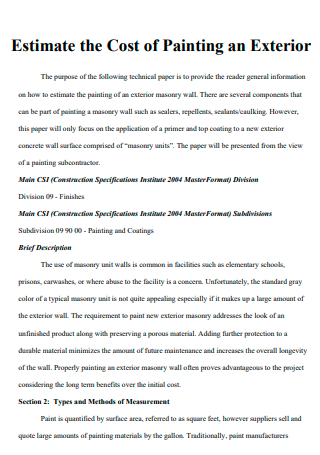
Painting Exterior Estimate
download now -

Painting Estimate Example
download now -
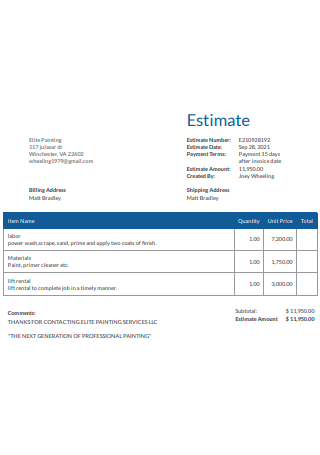
Basic Painting Estimate
download now -

Painting and Framing Estimate
download now -
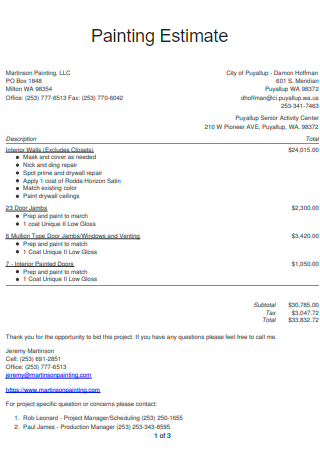
Painting Estimate in PDF
download now -
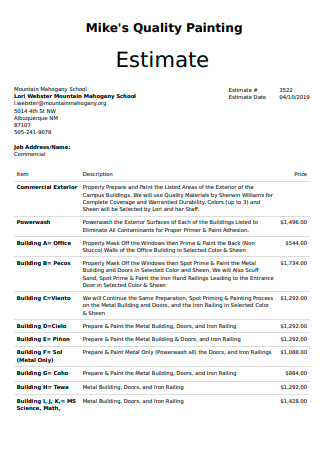
Quality Painting Estimate
download now -
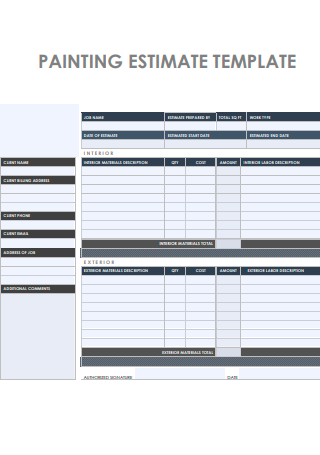
Painting Estimate Template
download now -

Painting Estimate Form
download now
FREE Painting Estimate s to Download
7+ SAMPLE Painting Estimate
What Is a Painting Estimate?
Things to Prepare When Making a Painting Estimate
Factors to Include in a Paint Estimate
How to Write a Painting Estimate
FAQs
How to figure painting estimates?
How important is a painting estimator?
What to be careful of when engaging with a painting estimator?
What Is a Painting Estimate?
A Painting estimate is a document that displays the cost estimate for painting, specifically towards a specific medium such as used to adorn properties. Contractors may use a rough base rate per square foot, also needing to consider the paint cost and materials, the time it will take to paint, while some would offer the lowest price to outbid the competition. Each of these strategies could work, but if you want to build a successful business, it helps to be as exact as possible with your painting estimate. You can head on over to view the painting estimate examples for additional references.
Things to Prepare When Making a Painting Estimate
Clients may be tempted to hire the first professional painter who is available to renew the inside or outside of their house, but good fortune favors the patient homeowner. Most actually advise clients to get at least three painting estimates before settling on a single Contractor. As experienced painters will not only save the client’s time and energy, but you will also have the know-how to make the area seem beautiful when you are through, so clients won’t have to worry about noticeable brush strokes or missed places. Give this curated list a read to be better prepared before making a painting estimate.
Factors to Include in a Paint Estimate
When clients are searching for a painter to paint their business or residential properties, one of the first things they do is obtain an estimate. Some contractors utilize conventional forms, while others may use estimate software. Regardless of the estimating strategies adopted, the components considered in creating the estimate should be consistent. The Painters Contractors Association (PCA) recommends that its members include the following items in their estimates. This curated list serves as additional information to ensure you don’t forget anything before submitting it to the client. Having all of these factors within your painting estimate is sure to convince clients that you have everything prepared for them.
How to Write a Painting Estimate
Most homeowners may not be as convinced to hire you for the project, believing they could do it themselves. Although some are capable to do so, not everyone is well-equipped with the correct tools and set of skills. This is why writing a painting estimate is important to persuade them that hiring you is beneficial so they could save not only on the cost but also their efforts. This painting estimate guide has been prepared to show you what each section should contain. If you prefer, you can even use the painting estimate invoice template as you go about each step.
-
1. Indicate Parties Involved
Starting off the painting estimate would be mentioning the official name of your client or the associated company they work for, for a commercial painting job. Followed by the official address of their office building, their updated contact information, and even including their official logo. This goes the same way for you as well, as the official painter to do the project for the client. Avoid misspelling or typos in this part since it is the very first that will be read by the clients and other readers.
-
2. Do a Site Visit
Do yourself a favor and go see the location before you begin your estimate. There may be factors that push up the price, such as the condition of the walls. More time will be required if there are many accent walls and various colors. Then, using a laser measuring device, measure the room for yourself. Asking necessary questions ahead of time to improve the accuracy of your estimate and save you time later on. If you are new to painting or estimating, you can bring someone more experienced with you to the worksite. Take your time, and if feasible, consult with more experienced painting contractors to gain a comprehensive grasp of the industry.
-
3. Measure the Paintable Area and Its Condition
The estimator would have to calculate the total paintable area by multiplying the surface’s height and breadth and then subtracting the surface areas of the doors, windows, and fittings. Then he’d have to add all the paintable spots for each room or part of the outdoor areas to paint. Aside from measuring the paintable area, the kind of surface, such as concrete, wood, metal, or drywall, must also be considered. If they have a preference leave it as is or have it be painted over. Paint concerns for previously painted areas such as chalking, flaking, cracking, and so on. These must be evaluated since they will influence the Budget.
-
4. Estimate the Manpower
With only a fast walk-through, experienced paint estimators would have an estimate of how long it would take to work on a job. However, it is not so simple for a less experienced estimator. He would require instruction as well as hands-on experience. This is why the majority of estimators are also artists. The painting crew’s experience is very vital to consider. Who and how many painters arrive on the job site for a project are also determined by the customer, who may or may not want the job completed quickly. It is important to take note of the number of painters that will be doing the project to properly compensate them for their services
-
5. Estimate the Materials
When it comes to painting, the topcoat, which is often the paint in the color desired by the customer, is not the only factor to consider. Sundries or consumables include rollers, brushes, sandpaper, paint trays, painter’s tape, rags, cartons, empty cans, sandpaper, and so on. There are also non-consumables such as a spatula, putty knife, mortar gun, shovel, spray gun, and so on. When painting in difficult-to-reach regions, the crew may require higher platforms such as ladders, scaffolds, gondolas, and so on, which may require renting or purchasing.
-
6. Calculate All Expenses and Costs
When the paint estimator completes the painting estimate, it will be handed to the firm for review and to include overhead charges such as transportation, communication, insurance, taxes, employee benefits, and office rent. This is typical of properly managed paint companies. If done correctly, the estimator’s computation serves as the foundation for a lucrative project. If the estimate is incorrect, the firm may lose money. If it is both good and competitive, the company can win a project Bid and profit from it. As a result, the paint estimator is an essential team member in every painting job.
FAQs
How to figure painting estimates?
A paint estimate’s objective is not to win the project. As a result, you must exercise caution when selecting a painting contractor based only on pricing. Other contractors may not charge more, but to save money, they will speed through the project and utilize lesser quality paint and supplies which may not be good for the client in the longevity of their property, both private and commercial. Any painting estimate should include all costs associated with generating great results. If clients believe your painting estimate is missing in-depth, they should receive a thorough explanation regarding the estimate on painting a room.
How important is a painting estimator?
Since no two painting projects are alike, an estimate is a useful tool for both you and the painter. For example, you may believe that painting your living room a beige hue is a quick and uncomplicated task, but a local Interior painter can point out the prep work and other things you overlooked, such as correcting flaws such as nail pops and water stains. A painting estimate ensures that everyone involved is on the same page. It defines your expectations and proves that your painter knows exactly what you desire.
What to be careful of when engaging with a painting estimator?
Although not all of them can be lumped into a single category, there are fraudsters in the painting industry. You should be wary of any contractor that demands full payment up ahead. To begin the project, most reputable painters just want a portion of the ultimate charge. Make sure that the paint stated in the estimate is the actual paint used, and that it is of high quality. Never accept a verbal deal. Ascertain that the estimate and specifics are documented. Examine online reviews. Contractors cannot delete consumer reviews on reputable sites like Google and Facebook; make use of these insights.
Painting is a skill not everyone can execute, sure they can do it themselves and attempt to neatly paint their homes, but once you employ a painter or contractor, you will noticeably see the difference in the execution of their skills. This is why having a painting works estimate is important to ensure that your home will reflect the quality you aspire to express. Since guests and visitors will be paying you a visit, it is normal for you to want to achieve high-quality work done to the painting of the sections of your home. What are you waiting for? Make use of the available and readily provided painting estimate worksheet now to save you time and effort as opposed to drafting one from scratch.
